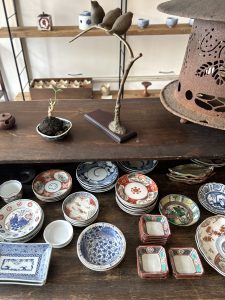一年を通して万能食材です(愛知県名古屋市千種区姫池通 骨董買取 古美術風光舎)
2024.06.15
皆さまこんにちは。スタッフHでございます。
全国的に夏日が続いておりますが、暑さはこれからが本番。長く続いたエルニーニョ現象も終息し、今年の夏は厳しい暑さになるようです。なんとか乗り切りたいものですね。

さて、本日6月15日は「生姜の日」とされています。生姜と言えば冬の寒い時期に体を温めるための食材というイメージがありますが、実は熱中症の予防や夏バテ防止にも効果があると言われています。
熱中症予防のためには少しずつ体を暑さに慣れさせていく‘暑気順化’が有効だと言われ、運動などで汗をかいて体温コントロール機能を正常にすることを勧められますが、これが中々大変です。そこで手軽な方法として「生姜」を摂取するという方法があります。
「生の生姜」には発汗を促す「ジンゲロール」が豊富に含まれており、体を内側から温め、全身の血流をよくすることで汗をかきやすくしてくれる効果があります。また生姜の香りは食欲を増進させ、胃腸の消化、吸収を高めてくれる効果もあり、暑くて食が進まない時に、冷ややっこやそうめんの薬味としては最適です。
更に抗菌作用もあり食材を傷みにくくすることも可能だそうです。
また生ではなく、生姜を加熱したり干したりすると体を温める成分の「ショウガオール」が増えます。夏でも冷房で冷えた室内に長くいたり、冷たい飲み物ばかりを飲んでいると体が冷えて体調を崩しがちです。そんな時は生ではなく加熱した生姜を摂取するという方法もあり、いわゆる万能食材です。実際に漢方には欠かせない生薬で、葛根湯や桂枝湯など約8割の漢方薬に生姜が含まれているそうです。
最近ではショウガオールやジンゲロールは老化の原因となる活性酸素を除去する働きがあり、体内の酸化を防ぎ老化を遅らせる効果があるともいわれ、効能はまだまだ計り知れないようです。
ただ胃腸が弱い人が大量に摂取すると不調を引き起こすこともあり、摂り過ぎは禁物とのこと。何事もバランスが大事なのですね。
先ほど本日6月15日は「生姜の日」とお伝えしましたが、こちらは石川県金沢市の波自加彌(はじかみ)神社で生姜を祀る「はじかみ大祭」が行われることに由来しているとされています。
波自加彌神社の名前の由来は、生姜やわさび、山椒などの「歯で噛んで辛いもの」の古語で「薑・椒(はじかみ)」が語源とされているようです。
奈良時代に加賀国で数カ月間雨が降らず、国造(くにのみやつこ)が雨乞いをするために波自加彌神社に参拝し、断食して祈願しました。37日目に神社近くより水が湧き出たそうです。人々はお礼のお供えをするにも干ばつ続きで作物がなく、自生していた生姜を献じて感謝の祭りをしました。その日が6月15日で「はじかみ大祭」の始まりだといわれています。参拝者に振る舞われる生姜湯はこの湧き出た水を使って作られています。
日本で唯一「香辛料」を祀る神社で、県内外から生姜を扱う生産者・業者が自社製品を献納し、会社の発展を祈願しているとのことです。
「はじかみ」と聞くと焼き魚などに添えられている紅白の葉生姜を思い浮かべます。こちらは「矢生姜(はじかみ)」と書くようで矢のような形をしていることに由来しているとのこと。
子供の頃、これは食べていいものなのかどうかと悩み、周囲の大人をちらちらと覗き見していました。矢生姜は料理の口直しの意味があり、マナーとしては魚をいただいた後に白くて柔らかい根の部分だけをいただきます。子供には少し辛すぎて、吐き出すこともできず無理やり飲み込んだような…。苦い思い出です。
それでは、また次の機会に。

Hello everyone. This is Staff H.
Summer days are continuing nationwide, but the heat is just beginning. The long-lasting El Niño phenomenon has ended, and this summer is expected to be very hot. I hope we can manage to get through it.
Today, June 15, is “Ginger Day. Ginger is often thought of as an ingredient to warm the body during the cold winter months, but in fact, it is said to be effective in preventing heat stroke and summer fatigue.
It is said that “heat acclimatization,” in which the body gradually becomes accustomed to the heat, is effective in preventing heat stroke, and it is recommended that the body temperature control function be normalized by sweating through exercise, etc. However, this can be quite difficult. However, this is not easy. One easy way is to consume ginger. Fresh ginger is rich in gingerol, which promotes perspiration, warms the body from the inside, and improves blood flow throughout the body, making it easier to sweat. The aroma of ginger also increases appetite and improves digestion and absorption in the gastrointestinal tract, making it an ideal condiment for cold yakko or somen noodles when it is too hot to eat.
It also has antibacterial effects and can prevent food from being damaged.
When ginger is heated or dried instead of raw, the amount of gingerol, a component that warms the body, increases. Even in summer, if you stay in an air-conditioned room for a long time or drink only cold drinks, your body tends to get cold and you tend to get sick. In such cases, you can take heated ginger instead of raw ginger, which is a so-called versatile ingredient. In fact, ginger is an indispensable herbal medicine in Chinese medicine, and about 80% of Chinese herbal medicines, such as Kakkon-to and Katsurae-to, contain ginger.
Recently, gingerol and gingerol are said to eliminate active oxygen that causes aging, preventing oxidation in the body and delaying aging, and their efficacy is still immense.
However, people with weak gastrointestinal tracts should not take too much, as it may cause problems if taken in large quantities. It is important to keep a good balance in everything.
I mentioned earlier that today, June 15, is “Ginger Day,” which is said to derive from the “Hajikami Grand Festival” held at Hajikami Shrine in Kanazawa City, Ishikawa Prefecture, where ginger is enshrined.
The name of Hajikami Shrine is believed to be derived from “Hajikami,” an archaic word for ginger, wasabi (Japanese horseradish), sansho (Japanese pepper), and other “spicy foods chewed with the teeth.
During the Nara period (710-794), there was no rain for several months in Kaga Province, and the Kuninomiyatsuko (a local municipality) went to Hajikaya Shrine to pray for rain, fasting for several days. The people were unable to produce any crops due to the drought, so they offered ginger, which grew wild, as a festival of thanksgiving. That day, June 15, is said to be the beginning of the Hajikami Grand Festival. The ginger tea served to worshippers is made using water from this spring.
It is the only shrine in Japan dedicated to “spices,” and producers and traders of ginger from inside and outside the prefecture dedicate their products and pray for the development of their companies.
When I hear the word “Hajikami,” I think of the red and white leaf ginger served with grilled fish and other dishes. Hajikami is written as “arrow ginger (hajikami)” and is said to be derived from its arrow-like shape.
When I was a child, I used to glance at the adults around me, wondering if this was something I was allowed to eat. Arrow ginger is meant to cleanse the palate of the dish, and as a matter of etiquette, only the white, soft root part is taken after the fish is served. It was a little too spicy for children, and they could not spit it out, so they forced themselves to swallow it…. It is a bitter memory.
I will see you next time.
*******************
ご実家の整理やお片付けなどをされている方のご相談などが多くございます。
お片付けなどくれぐれもご無理のないようになさってくださいませ。
風光舎では古美術品や骨董品の他にも絵画や宝石、趣味のお品など様々なジャンルのものを買受しております。
お片付けをされていて、こういうものでもいいのかしらと迷われているものでも、どうぞお気軽にご相談下さいませ。
また風光舎は、出張買取も強化しております。ご近所はもちろん、愛知県内、岐阜県、三重県その他の県へも出張いたします。
まずは、お電話お待ちしております。
愛知県名古屋市千種区姫池通
骨董 買取【古美術 風光舎 名古屋店】
TEL052(734)8444
10:00-18:00 OPEN

